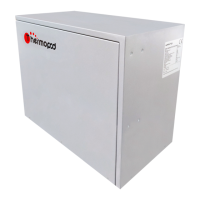
Do you have a question about the HARNITEK Thermopod and is the answer not in the manual?
Explains the meaning of various symbols used in the manual for caution, warnings, and important notes.
Provides instructions for the environmentally responsible disposal of packaging materials and the Thermopod unit.
Details suitable and unsuitable locations for installing the Thermopod unit, considering environmental factors.
Guidance on safely handling the unit during installation and relocation, including unpacking and moving procedures.
Outlines essential safety measures and requirements for performing electrical connections.
Specifies crucial checks to be performed before initiating the system's test run.
Lists and illustrates the key components that make up the Thermopod unit and system.
Details the standard fittings provided with the Thermopod system for installation.
Lists the water fittings and accessories supplied as part of the Thermopod system.
Lists components used specifically for the installation of Thermopod panels.
Lists components used specifically for the installation of the main Thermopod unit.
Lists the spare parts included in the supplied components package.
Details the performance metrics of the Thermopod unit, including power output and thermal performance.
Provides the physical dimensions and weight specifications for the Thermopod unit.
Lists the types and sizes of connections available on the Thermopod unit.
Details general specifications such as operating current, temperature range, and sound level.
Illustrates the physical dimensions of the Thermopod unit through various views.
Describes the general finish, material, protection, and installation orientation of the panels.
Provides the physical dimensions and weight specifications for the Thermopod panels.
Guidance on choosing the optimal location for the Thermopod unit, considering proximity and access.
Details specific criteria for selecting an installation location, avoiding hazards and optimizing performance.
Specifies the maximum allowed horizontal distance between the Thermopod unit and the cylinder.
Specifies the maximum allowed vertical distance between the Thermopod unit and the cylinder.
Details how to mount the Thermopod unit using brackets, including positioning and securing.
Step-by-step instructions for drilling and fitting the mounting brackets onto the wall.
Instructions on how to attach the Thermopod unit to the installed brackets securely.
General considerations and checks before making hydraulic connections to the system.
Identifies the location of water in and out ports on the Thermopod unit for connection.
Details the type of pipes and importance of insulation for water connections.
Emphasizes the necessity of insulating all water pipes to minimize heat loss and maintain performance.
Illustrates the hydraulic connections for an unvented system, showing water flow from the cylinder top.
Diagram showing hydraulic connections for an unvented system with water source from the cylinder side.
Illustrates the hydraulic connections for a vented system, showing water flow from the cylinder top.
Explains how cylinder water inlet/outlet connect to vented and unvented systems.
Illustrates the correct and incorrect placement of the Y-filter for optimal system functionality.
Lists components and provides guidance for assembling the multi-purpose waterway.
Provides recommended distances and considerations for positioning panels relative to the Thermopod unit.
Advice on selecting an appropriate location for the Thermopod panels, considering pipe runs and height.
Details on the location, angle, and orientation for installing Thermopod panels externally.
Illustrates panel positioning, fixing points, and spacing between panels.
Step-by-step guide for installing Thermopod panels vertically on a wall.
Guidance for installing Thermopod panels on an inclined roof surface.
Details the process of connecting gas and liquid lines to the Thermopod panels.
First step in connecting the gas line outlet (A) to the 3/8" outlet line connection.
Second step in connecting the liquid line inlet (B) to the 1/4" inlet line connection.
Details the process of connecting the 1/4" and 3/8" refrigeration pipes between unit and panels.
Identifies and links refrigeration pipes to connections near the Thermopod panel.
Identifies and links refrigeration pipes to connections at the bottom of the Thermopod unit.
Procedure for testing pipe connections for leaks using soap foam and nitrogen pressure.
Details the critical process of removing air and moisture from the system before refrigerant charging.
Explains how to calculate and add refrigerant based on pipe length extension.
Key conditions and requirements to check before implementing electrical connections.
Details the connection procedure for the electrical immersion heater.
Provides the electrical schematic diagram of the Thermopod system, including electric immersion.
Illustrates the wiring configuration for connecting multiple Thermopod units online.
Instructions on setting unique dial codes for each machine in an online configuration.
Guidance on checking display device functionality and terminal connections after setup.
Steps to navigate and check current machine parameters and status (online/offline).
Step-by-step instructions for setting the local time on the Thermopod digital controller.
Details on adjusting hours and minutes, and confirming the time setting on the controller.
Instructions for initiating system operation, including water pump and compressor activation.
Procedures for commissioning the system, including initial checks and monitoring operation for 30 minutes.
Lists system parameters, their definitions, setting ranges, and default values.
Explains unit status codes, display ranges, and provides comments for various system states.
Guidelines for cleaning the Thermopod unit and performing maintenance, including draining.
Provides steps for relocating the Thermopod unit while ensuring refrigerant containment.
Lists error codes generated by the system and their corresponding error names.
Provides causes and solutions for common problems encountered with the Thermopod system.
Outlines the terms and conditions that apply to the Thermopod's guarantee.
Fields for collecting customer contact and address information for warranty registration.
Fields for collecting information about the sales company involved in the purchase.
Fields for collecting information about the installer who performed the system setup.
Fields for recording product model, serial number, installation date, and invoice details.
